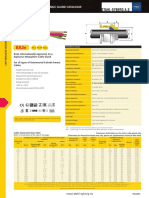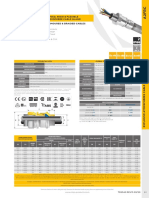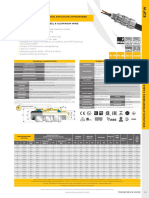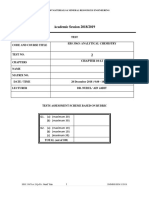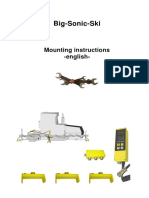Connection Solutions: AI 301 / Issue V - 03/16
Connection Solutions: AI 301 / Issue V - 03/16
Uploaded by
HalenaBuanCopyright:
Available Formats
Connection Solutions: AI 301 / Issue V - 03/16
Connection Solutions: AI 301 / Issue V - 03/16
Uploaded by
HalenaBuanOriginal Description:
Original Title
Copyright
Available Formats
Share this document
Did you find this document useful?
Is this content inappropriate?
Copyright:
Available Formats
Connection Solutions: AI 301 / Issue V - 03/16
Connection Solutions: AI 301 / Issue V - 03/16
Uploaded by
HalenaBuanCopyright:
Available Formats
Assembly Instructions for cable gland:
ICG 653/UNIV Exd IIC Gb / Exe IIC Gb / Extb IIIC Db
AI 301 / Issue V - 03/16
Operating temperature range -60°C +80°C Certification Details
Gland Type: ICG 653/UNIV Exd IIC Gb / Exe IIC Gb / Extb IIIC Db
1 Baseefa06ATEX0058X II 2 GD IP66
IECEx BAS06.0015X
2 IEx 14.0272X
EAC ТC RU C-GB.ГБ05.B.00750
c CSA us No: 1024328
Class 1 Zone 1 AExd IIC, AExe II,
3 Zone 21 AExtD
Class 1 Div 2 ABCD, Class II Div 2 Groups EFG, Class III
CNEx12.3448X
4
5
Reversible Armour Clamping Ring (RAC)
General identification ring orientation for:
6
Braid 'X',
SWA Flat Steel Wire 'Y',
Position Steel Tape 'Z'
Ring Position
1. Backnut
2. Middle Nut
3. Reversible Armour Clamping Ring (RAC)
4. Armour Spigot
5. Rubber Pot
6. Entry (with captive deluge seal)
IMPORTANT: The arrowhead indicating the
correct armour thickness or type should point
towards the equipment
Note: Armour cable acceptance sizes are marked on
Cable Preparation Gland Preparation the clamping ring.
II
6
5
Armour / braid
4
I I
4
3
3 3
Note:
Tape armour must be 2
re-trimmed at 90° to the
2 vertical axis of the cable 2
after it has been spread,
to ensure that the full 1
face is correctly
1 presented. 1
Shroud option
A B C
Strip Cable to suit equipment as shown above and Push the cable through the armour spigot . Spread Remove the rubber pot from the entry . Place
expose the armour/braid 'I' removing all cable fillers. armour/braid over the armour spigot until the end the entry over the armour spigot . Move the
'I' = 20mm for cable gland sizes Os to A of the armour/braid is up against the shoulder of the sub-assembly and up to meet the entry .
'I' = 25mm for cable gland sizes B to C2 armour cone. Position the armour clamping ring .
'I' = 32mm for cable gland sizes D to F
'II' to suit equipment.
If required, fit shroud.
See Notes re. Drain Wires.
Connection Solutions www.ehawke.com
Hawke International is a division of Hubbell Ltd. UK Office Sales: +44 (0) 161 830 6698
Registered No. 669157 in England. Registered Office: Oxford Street West, Technical: +44 (0) 161 830 6697
Cannon Place, 78 Cannon Street, London EC4N 6AF. Ashton-Under-Lyne, Fax: +44 (0) 161 830 6648
A member of the Hubbell Group of Companies Lancashire. OL7 0NA. UK E-mail: sales@ehawke.com AI 301 - Issue V / Page 1 of 4
6
Compound
6
4
4
3
2 2
2
D E F
Hold the entry in position with a spanner/wrench Unscrew the middle nut and visually inspect that Remove the entry , spread the cable cores out for
to prevent rotation. Hand tighten the middle nut the armour/braid has been successfully clamped the compound packing. Pack the compound between
onto the entry and turn a further half to three between the armour spigot and the armour the cores shown. See notes below and Fig. 7 for
quarters of a turn with a spanner/wrench. clamping ring . If armour/braid not clamped repeat compound preparation.
assembly.
EPOXY COMPOUND PREPARATION
When handling this material, the gloves supplied must be worn. The epoxy compound is supplied in the form of a two part package. These should be mixed into the
ratio of 1:1 until both colours have blended into one, without any streaks. Rolling and folding is the most satisfactory method of obtaining an even blend. Once mixed,
the compound must be used within 30 minutes. After this time it will begin to stiffen. The compound should be kept at an ambient temperature of no less than 20°C
prior to using. At lower temperatures it becomes difficult to mix. Should any compound come into contact with the skin it should be cleaned off with skin cleaner and
not allowed to dry on the skin. Only compound for immediate terminations should be mixed.
The mixing and installation of the compound at an ambient temperature below 4°C is not recommended due to extended curing periods.
The storage of the compound shall be at temperatures between 5°C and 30°C.
Tape
6
5 Remove surplus 6
compound
Compound
35mm
5
2
4
Remove surplus 1
compound
G H I
With all gaps and voids filled, bring the conductors Replace the entry over the rubber pot ensuring Locate and hand tighten the sub-assembly and
back together and pack more compound around the that compound does not cover the end of . to the entry .
outside of the conductors. Tape the conductors
together to prevent disturbance of the compound IMPORTANT: The conductors must not be
seal. Pass the rubber pot over the armour spigot moved for a minimum of four hours.
and remove any surplus compound. from the top of
rubber pot and the joint face as indicated.
AI 301 - Issue V / Page 2 of 4
6
5
6
2
1
1
J K
Allow the compound to cure. (See Fig. 7 for Curing Times). Untighten Re-assemble the rubber pot and the entry . Tighten the
the sub-assembly and from the entry to enable inspection. sub-assembly and to the entry until resistance is felt and
The rubber pot may be removed for inspection to ensure that the add half to three quarters of a turn to with a spanner / wrench.
packing is satisfactory. Tighten the backnut to form a seal around the cable, then
tighten a further full turn using a wrench / spanner. Ensure that
Add further compound if necessary the middle nut does not rotate when tightening the backnut.
Ensure that the deluge seal is pulled down into position. Locate
the shroud over the cable gland, if applicable.
The following instructions are the various BASEEFA approved methods of passing drain wires etc. through the compound barrier
and should be followed if permitted by cable installation specifications.
DRAIN WIRE PREPARATION
1.0 INSULATING DRAIN WIRES WITH HEAT SHRINK OR COLD SHRINK TUBING
1.1 Fold back the armour / braid and bend it to right angles from the inner sheath.
1.2 Remove foils and tape level with the outer sheath, exposing the drain wires and insulated conductors. Cut back a further 10mm of inner sheath.
1.3 Pass 100mm length of heat shrink or cold shrink tubing over the drain wire until it comes into contact with the foils, then shrink the tubing evenly down onto the drain wire
so that no air pockets occur.
1.4 To insulate the joint between the foils and the tubing a suitable piece of 10mm long shrink tubing or neoprene stretch tubing or a 10mm wide lap of PVC tape may be used.
1.5 After completing 1.1 to 1.4 on each drain wire, lay the armour / braid parallel to the cable, if applicable, then carry out instruction B.
2.0 INSULATING DRAIN WIRES / SCREENS WITH SEPARATE INSULATED CRIMPED CONDUCTORS OR SOLDERED CONNECTION
2.1 Fold back the armour / braid and bend to right angles from the inner sheath.
2.2 Remove a further 15mm of inner sheath (See Fig. 1).
2.3 Unravel one or two groups of wires from the screen wires, then remove the remainder of the screen wires (See Fig. 2).
2.4 Twist the group of screen wires into a pigtail and cut to 15mm long.
2.5 Crimp an insulated conductor to the pigtail wih a suitable insulated butt ferrule (or soldered connection), leaving enough length of the insulated conductor to enable the
remote end to be connected to the earth terminal in the equipment. (See Fig. 3). Note: There shall be a minimum of 10mm of compound on both ends of the crimped
/soldered joint.
2.6 To insulate the joint between the screen wires and the insulated conductor, place one lap of PVC insulating tape over the exposed metallic joint.
2.7 After completing 2.1 to 2.6 on each drain wire, lay the armour / braid parallel to the cable. Then carry out instruction B.
Armour / braid Inner Sheath One or two groups
of screen wires
Screen Wires
Fig. 1 15mm Fig. 2 Fig. 3
Crimp or Insulated
Solder Conductor
3.0 INSULATING DRAIN WIRES WITH INSULATING VARNISH OR PAINT
3.1 Fold back the armour / braid and bend it at right angles from the inner sheath.
3.2 Remove the foil and tape level with the inner sheath exposing the drain wires and conductor pairs.
3.3 Cut back a further 10mm of inner sheath (See Fig. 4).
3.4 Spray or paint the drain wires with insulating varnish or paint, then leave to dry (See Fig. 5)
3.5 To insulate the foil ends a suitable piece of 10mm long shrink tubing or neoprene stretch tubing or a 10mm wide lap of PVC tape may be used (See Fig. 6).
3.6 After completing 3.1 to 3.5 on each drain wire, lay the armour / braid parallel to the cable. Then carry out instruction B.
Armour / braid Inner Sheath
Foils
Outer Sheath
Fig. 4 Drain Wire Sleeving
10mm Fig. 5 Fig. 6
Insulated
Drain Wire
AI 301 - Issue V / Page 3 of 4
Epoxy Compound
Cure Time Vs. Temperature
90
The compound may be adversely affected by some
80
Shore Hardness
solvent vapours. If such vapours are likely to be
70 present in the vicinity of the cable gland in service,
suitable precautions may be necessary.
60
(Contact Hawke's Technical Dept).
50
40 The compound cures at a Shore D hardness of 85,
40 ºC
30 when it can be handled. The compound when fully
25 ºC cured is suitable for use at a temperature range of
20 -60°C to +80°C.
4 ºC
10
0
4 8 12 16
Time (Hours) Fig. 7
CABLE GLAND SELECTION TABLE
Cable Acceptance Details
Entry Thread Hexagon
Compressed
Outer Steel Wire Armour/
Maximum
Size Inner Sheath/Cores Dimensions
Length
Length
Size Sheath Tape/Braid
Ref Max. Max. ATEX
Orientation Orientation Across Across
Metric NPT Over Inner Max. No. Min. Max.
Cores Sheath of Cores
1 2 Flats Corners
Os M20 ½" 8.9 10.0 12 5.5 12.0 0.8/1.25 0/0.8 67.0 83.0 24.0 26.5
O M20 ½" 8.9 10.0 12 9.5 16.0 0.8/1.25 0/0.8 67.0 83.0 24.0 26.5
A M20 ½" - ¾" 11.0 12.5 15 12.5 20.5 0.8/1.25 0/0.8 67.0 84.0 30.0 32.5
B M25 ¾" - 1" 16.2 18.4 30 16.9 26.0 1.25/1.6 0/0.7 73.6 91.0 36.0 39.5
C M32 1" - 1¼" 21.9 24.7 42 22.0 33.0 1.6/2.0 0/0.7 78.0 98.0 46.0 50.5
C2 M40 1¼" - 1½" 26.3 29.7 60 28.0 41.0 1.6/2.0 0/0.7 82.4 100.0 55.0 60.6
D M50 1½" - 2" 37.1 41.7 80 36.0 52.6 1.8/2.5 0/1.0 88.7 116.0 65.0 70.8
E M63 2" - 2½" 47.8 53.5 100 46.0 65.3 1.8/2.5 0/1.0 92.7 124.0 80.0 88.0
F M75 2½" - 3" 59.0 66.2/65.3 120 57.0 78.0 1.8/2.5 0/1.0 99.4 122.0 95.0 104.0
ACCESSORIES: SCHEDULE OF LIMITATIONS - Baseefa ATEX / IECEx:
Before cable gland assembly or stripping of the cable gland assembly, 1. These glands are suitable for use within an operating temperature range of
consideration should be given to any cable gland accessories that may be -60°C to +80°C.
required, such as: -
2. When the gland is used for increased safety, the entry thread shall be
Shroud, to offer additional corrosion protection. suitably sealed to maintain the ingress protection rating of the associated
Locknut, to secure cable glands into position. enclosure.
Sealing washer, to offer additional ingress protection of the enclosure at the
cable gland entry.
Earthtag, to provide an external armour / braid bonding point.
Serrated washer, to dampen any vibrations that may loosen the locknut or
cable gland assembly.
NOTES - c CSA us:
EC Declaration of Conformity in accordance with European Directive 94/9/EC (until 19th
1. Class 1 Division 2 suitable for Marine Shipboard
April 2016) and
applications only according to CSA Standard 245 and
EU Declaration of Conformity in accordance with European Directive 2014/34/EU (from
IEEE45 / IEC 600092-353 Standards, or certified equivalent,
20th April 2016)
for use on Shipboards and Offshore Rigs / Platforms only.
Manufacturer: Hawke International
Address: Oxford Street West, Ashton-under-Lyne, OL7 0NA, United Kingdom.
2. Glands must comply with the Canadian Electrical Code
and National Electric Code requirements for threaded
Equipment: Group II Barrier Cable Glands Type: ICG 653/UNIV
entries.
Provisions of the Directive fulfilled by the Equipment:
3. For Exe applications, a sealing washer or thread sealant
Group II Category 2GD Exe IIC Gb, Exd IIC Gb, Extb IIIC Db – IP66
may be required between the enclosure and the gland to
Notified Body for EC-Type Examination: SGS-Baseefa 1180 Buxton UK
maintain the IP rating of the enclosure.
EC-type Examination Certificate: Baseefa06ATEX0058X
Notified Body for production: SGS-Baseefa 1180 Buxton UK
4. Drain wires and earth screening may pass through the
Harmonised Standards used:
compound barrier using one of the methods which are
EN 60079-0:2012+A11:2013, EN60079-1:2014, EN60079-7:2015, EN60079-31:2014.
details in this assembly instruction; heat shrink or cold
shrink tubing, or addition of an insulated crimped or
On behalf of the above named company, I declare that, on the date the equipment
soldered conductor or insulation by varnish or paint.
accompanied by this declaration is placed on the market, the equipment conforms with all
technical and regulatory requirements of the above listed directives.
5. This cable gland may only be installed when temperature
is above +4°C. After completion of the installation, the
assembly is then suitable for -60°C to +80°C.
………………………………….
…………………
A. Tindall
Technical Manager
AI 301 - Issue V / Page 4 of 4
You might also like
- Assembly Instructions Cable Gland 501 453 UniversalDocument3 pagesAssembly Instructions Cable Gland 501 453 UniversalempibkNo ratings yet
- Hookes LawDocument23 pagesHookes LawAman Singh100% (2)
- Pupil AnswersDocument125 pagesPupil AnswersSofiaaaar83% (6)
- Heat Conduction Lab ReportDocument3 pagesHeat Conduction Lab ReportJohnConor96% (24)
- SLIDE2-Basic Rock PptiesDocument100 pagesSLIDE2-Basic Rock PptiesolaseyeNo ratings yet
- AI302Document3 pagesAI302MakiberNo ratings yet
- Assembly Instructions Cable Gland 501 453 RACDocument3 pagesAssembly Instructions Cable Gland 501 453 RACempibkNo ratings yet
- CMP Products Cable Gland CatalogueDocument1 pageCMP Products Cable Gland Cataloguesuhaili pedroNo ratings yet
- 17p+OS EXBF F - Ver.2210Document1 page17p+OS EXBF F - Ver.2210deckard.kim10No ratings yet
- CMP E1fxDocument1 pageCMP E1fxmohd darusNo ratings yet
- CMP E1FW Kaapelilapivienti DatasheetDocument1 pageCMP E1FW Kaapelilapivienti Datasheetmehdi HKNo ratings yet
- CMP Products Cable Gland Catalogue: TDS547 REV16 04/19Document1 pageCMP Products Cable Gland Catalogue: TDS547 REV16 04/19po truongNo ratings yet
- CMP A2fDocument1 pageCMP A2fmohd darusNo ratings yet
- CMP Products Cable Gland Catalogue: TDS548 REV11 06/18Document1 pageCMP Products Cable Gland Catalogue: TDS548 REV11 06/18BaoLCNo ratings yet
- 25p+OS A2F U - Ver.2210Document1 page25p+OS A2F U - Ver.2210vijaymuruganGNo ratings yet
- CMP Products Cable Gland CatalogueDocument1 pageCMP Products Cable Gland CatalogueJack CadNo ratings yet
- CMP E1fw Nickel PlatedDocument1 pageCMP E1fw Nickel PlatedHen Drix LevaNo ratings yet
- Cable GlandsDocument13 pagesCable Glandsharry jangNo ratings yet
- CMP Products Cable Gland CatalogueDocument1 pageCMP Products Cable Gland CataloguesubramanyaNo ratings yet
- CMP Products Cable Gland CatalogueDocument1 pageCMP Products Cable Gland Cataloguesogetsu kazamaNo ratings yet
- Digital Logic Isolation. Line Receiver. Power Supply Control Switching Power Supply Transistor InverterDocument9 pagesDigital Logic Isolation. Line Receiver. Power Supply Control Switching Power Supply Transistor InverteracruwerNo ratings yet
- TLP2200 Datasheet en 20170821Document7 pagesTLP2200 Datasheet en 20170821SaikumarNo ratings yet
- A2F-FF: CMP Products Cable Gland CatalogueDocument1 pageA2F-FF: CMP Products Cable Gland CataloguePaulo CostaNo ratings yet
- 6N136 Datasheet en 20140922 PDFDocument8 pages6N136 Datasheet en 20140922 PDFAdal VeraNo ratings yet
- 6N136 Datasheet en 20140922 PDFDocument8 pages6N136 Datasheet en 20140922 PDFLucasNo ratings yet
- TLP750 DatasheetDocument7 pagesTLP750 DatasheetArjun KrishnaNo ratings yet
- Item 3-Cable gland-16A2F1RADocument1 pageItem 3-Cable gland-16A2F1RAlpczyfansNo ratings yet
- Copie 14463 HAWKE ENCLOSURES GRP pdf-1311845849 pdf-1393321224Document10 pagesCopie 14463 HAWKE ENCLOSURES GRP pdf-1311845849 pdf-1393321224TTRRTTGFNo ratings yet
- 1 2 3 4 5 6 7 8 Pin No. Wire Wire Label 1 1 110 2 2 118 3 3 114 4 4 114 9 5 101 10 6 101A 13 7 121 14 8 125 20 9 129 12" Label Wires On Both EndsDocument1 page1 2 3 4 5 6 7 8 Pin No. Wire Wire Label 1 1 110 2 2 118 3 3 114 4 4 114 9 5 101 10 6 101A 13 7 121 14 8 125 20 9 129 12" Label Wires On Both Endsjads301179No ratings yet
- UK SKX 12-15 - TdsDocument8 pagesUK SKX 12-15 - Tdsyarik.rguNo ratings yet
- A2frc MetricDocument1 pageA2frc MetricSudar MyshaNo ratings yet
- CMP PX Type ResinDocument2 pagesCMP PX Type Resinmuhammad khuram usmanNo ratings yet
- R4 Chafe Chain DrawingsDocument1 pageR4 Chafe Chain DrawingsAndre CaetanoNo ratings yet
- Ficha Tecnica Tapón Hexagonal de Polyamide Ex-E Draco, Marca. BimedDocument2 pagesFicha Tecnica Tapón Hexagonal de Polyamide Ex-E Draco, Marca. BimedGiancarloEleNo ratings yet
- A2f MetricDocument1 pageA2f MetricbatrarobinNo ratings yet
- E2Fw Globally Approved, Explosive Atmosphere Cable Gland For Lead Sheathed Steel & Aluminium Wire Armoured CablesDocument1 pageE2Fw Globally Approved, Explosive Atmosphere Cable Gland For Lead Sheathed Steel & Aluminium Wire Armoured CablesSujith KarayilNo ratings yet
- HHI HKE Mult 387 STOPPING PLUG SPEC UK 2023 00552Document1 pageHHI HKE Mult 387 STOPPING PLUG SPEC UK 2023 00552shibin1vaNo ratings yet
- C2Kht: C2Kht Internationally Approved, Ex E, Explosive Atmosphere Cable Gland For All Types of Armoured CablesDocument1 pageC2Kht: C2Kht Internationally Approved, Ex E, Explosive Atmosphere Cable Gland For All Types of Armoured Cablesmhrdd222No ratings yet
- Ficha Tecnica Jack Cat 5eDocument1 pageFicha Tecnica Jack Cat 5eELIANA MARÍA SERNA VÉLEZ ALIANZAS ELÉCTRICAS S.A.SNo ratings yet
- Table 61C-1&61C-2 of ETCIDocument4 pagesTable 61C-1&61C-2 of ETCIblackberry7130gNo ratings yet
- Os-E1Uf: Application: Any Type of Armoured CableDocument1 pageOs-E1Uf: Application: Any Type of Armoured Cabledu lich clipNo ratings yet
- 889 td002 - en PDocument64 pages889 td002 - en PDias AnsNo ratings yet
- Peppers Datasheet 7.2.0 Type SPMH and SPHHDocument1 pagePeppers Datasheet 7.2.0 Type SPMH and SPHHHungNo ratings yet
- TMC2X NPTDocument1 pageTMC2X NPTmario cardenasNo ratings yet
- OS-A2F-U: Application: Non-Armoured CableDocument1 pageOS-A2F-U: Application: Non-Armoured Cablejack.izzatiNo ratings yet
- PdfcatalogDocument1 pagePdfcatalogxiaponaNo ratings yet
- Digispec Zero Speed Sensor (H, HH, HHQ) : Product DescriptionDocument2 pagesDigispec Zero Speed Sensor (H, HH, HHQ) : Product DescriptionWilfredo MolinaNo ratings yet
- Atex Range pg132-137Document6 pagesAtex Range pg132-137Zaki ElsayedNo ratings yet
- CMP E Type ExplosiveDocument2 pagesCMP E Type ExplosiveJorge Lazo GonzalesNo ratings yet
- TMC2 NPTDocument1 pageTMC2 NPTBrand MejysNo ratings yet
- 380V, 50HZ, 10KA, 40A Connection Through Pan Assembly: Circuit Name Circuit NoDocument1 page380V, 50HZ, 10KA, 40A Connection Through Pan Assembly: Circuit Name Circuit NoislamabyadNo ratings yet
- Te1fu PDFDocument1 pageTe1fu PDFkhaldoun samiNo ratings yet
- Crouse Hinds Ejb Enclosures Catalog PageDocument8 pagesCrouse Hinds Ejb Enclosures Catalog PagecinthiacruzNo ratings yet
- 31p+OSER-Z Ver.2110Document1 page31p+OSER-Z Ver.2110Roby Candra TarunaNo ratings yet
- Brochure Go Switch 7j Topworx en 82898Document4 pagesBrochure Go Switch 7j Topworx en 82898Septiana DamayantiNo ratings yet
- Presentation On CEL SSDAC PDFDocument506 pagesPresentation On CEL SSDAC PDFPrince Shah83% (6)
- Experiment No. 4 Astable & Monostable Multivibrator Using 555 TimerDocument7 pagesExperiment No. 4 Astable & Monostable Multivibrator Using 555 TimerchaitanyaNo ratings yet
- Why Use Isolated Signal ConditionersDocument19 pagesWhy Use Isolated Signal ConditionersshajilNo ratings yet
- Neon MNC Clevo m740s m741s m745s m760s m765s m766s m767sDocument39 pagesNeon MNC Clevo m740s m741s m745s m760s m765s m766s m767sHerjidi KurniawanNo ratings yet
- Rotex Solenoid ValveDocument7 pagesRotex Solenoid ValvejoseNo ratings yet
- TLP750 Datasheet en 20190610Document7 pagesTLP750 Datasheet en 20190610Gabriel EscamillaNo ratings yet
- The Fourth Terminal: Benefits of Body-Biasing Techniques for FDSOI Circuits and SystemsFrom EverandThe Fourth Terminal: Benefits of Body-Biasing Techniques for FDSOI Circuits and SystemsSylvain ClercNo ratings yet
- Physics and Technology of Crystalline Oxide Semiconductor CAAC-IGZO: Application to LSIFrom EverandPhysics and Technology of Crystalline Oxide Semiconductor CAAC-IGZO: Application to LSINo ratings yet
- On-Chip Electro-Static Discharge (ESD) Protection for Radio-Frequency Integrated CircuitsFrom EverandOn-Chip Electro-Static Discharge (ESD) Protection for Radio-Frequency Integrated CircuitsNo ratings yet
- MI70 Measurement Indicator and Handheld Meters For Dewpoint and Carbon DioxideDocument2 pagesMI70 Measurement Indicator and Handheld Meters For Dewpoint and Carbon DioxideHalenaBuanNo ratings yet
- Copper Alloy Split Bolt Connectors: Types S and SELDocument2 pagesCopper Alloy Split Bolt Connectors: Types S and SELHalenaBuanNo ratings yet
- Product Data Sheet: Contactor iCT - 2 Poles - 2 NO - 40 A - 220..240 V ACDocument2 pagesProduct Data Sheet: Contactor iCT - 2 Poles - 2 NO - 40 A - 220..240 V ACHalenaBuanNo ratings yet
- General Specifications: GS 05P03D21-01ENDocument8 pagesGeneral Specifications: GS 05P03D21-01ENHalenaBuanNo ratings yet
- Low Voltage General Purpose Transformers - 15T2FDocument2 pagesLow Voltage General Purpose Transformers - 15T2FHalenaBuanNo ratings yet
- Gaalship Offshore Cables: SW4 (C) or SW2 (C) 150/250 VDocument2 pagesGaalship Offshore Cables: SW4 (C) or SW2 (C) 150/250 VHalenaBuanNo ratings yet
- Eiadp1020 DTS0183 enDocument4 pagesEiadp1020 DTS0183 enHalenaBuanNo ratings yet
- Liquiphant: Point Level Detection in LiquidsDocument49 pagesLiquiphant: Point Level Detection in LiquidsHalenaBuanNo ratings yet
- Coating Inspection: For The Professional Coating InspectorDocument2 pagesCoating Inspection: For The Professional Coating InspectorHalenaBuanNo ratings yet
- Motor Control Switchrack: Installation & Maintenance InformationDocument3 pagesMotor Control Switchrack: Installation & Maintenance InformationHalenaBuanNo ratings yet
- Learn Laravel in 1 Week: Devan SingaramDocument35 pagesLearn Laravel in 1 Week: Devan SingaramLeonard Rumisov100% (1)
- Inter HWKDocument5 pagesInter HWKMohammed Elias AlamNo ratings yet
- PCBC TutorialDocument74 pagesPCBC Tutorialvelimier100% (1)
- ME324 Jeopardy2Document22 pagesME324 Jeopardy2Catherine AndersonNo ratings yet
- BIOENERGETICSDocument341 pagesBIOENERGETICSAvinashNo ratings yet
- Chemical Composition of Mung BeanDocument8 pagesChemical Composition of Mung BeanEuler MiquilenaNo ratings yet
- Roller Kelly BushingRoller Kelly Bushings Heavy Duty Pin Drive Square D...Document4 pagesRoller Kelly BushingRoller Kelly Bushings Heavy Duty Pin Drive Square D...farisNo ratings yet
- Blade Gen ReportDocument80 pagesBlade Gen ReportSunil NairNo ratings yet
- Absint : Section SectionDocument50 pagesAbsint : Section SectionsavitaNo ratings yet
- EBS 336 - Tests 2 - Q&A - 2018 PDFDocument4 pagesEBS 336 - Tests 2 - Q&A - 2018 PDFNurul Ain JabitNo ratings yet
- Tutorial 15Document5 pagesTutorial 15Pace AjjaNo ratings yet
- Feeder Accuracy PDFDocument12 pagesFeeder Accuracy PDFEE POG-III CSTPSNo ratings yet
- Cloudera Developer Training PDFDocument593 pagesCloudera Developer Training PDFGaddam NeerajNo ratings yet
- Math Standard (Part-4) Revision BookletDocument76 pagesMath Standard (Part-4) Revision BookletWild HogNo ratings yet
- FAI Sporting Code Section 3 - 2014Document32 pagesFAI Sporting Code Section 3 - 2014Thales GalvaoNo ratings yet
- 10-02-02101 Installation Manual Big-Ski Modular MOBA-Version enDocument23 pages10-02-02101 Installation Manual Big-Ski Modular MOBA-Version enalex72No ratings yet
- استردادDocument2 pagesاستردادnn1129374No ratings yet
- Differential Pulse Voltammetric Determination of Paracetamol at Nanogold Modified Indium Tin Oxide ElectrodeDocument5 pagesDifferential Pulse Voltammetric Determination of Paracetamol at Nanogold Modified Indium Tin Oxide ElectrodeYoselin GomezNo ratings yet
- Example #1 Forces and Moments On A Beam: Civilfem Manual of Advanced Examples - Ingeciber, S.A.Document19 pagesExample #1 Forces and Moments On A Beam: Civilfem Manual of Advanced Examples - Ingeciber, S.A.Percy Romero MurilloNo ratings yet
- FODS Prevoius PaperDocument4 pagesFODS Prevoius Paperflipkart6392No ratings yet
- Chapter 3 - Searching-Part 3Document64 pagesChapter 3 - Searching-Part 3Mohammed A. Al SattariNo ratings yet
- Engineering SeismologyDocument60 pagesEngineering SeismologyprashmceNo ratings yet
- Cisco D9865 Satellite Receiver Software Version 2.15 Installation and Configuration GuideDocument206 pagesCisco D9865 Satellite Receiver Software Version 2.15 Installation and Configuration GuideRicardo RodriguezNo ratings yet
- Fukuda Sangyo ST-95 Spiroanalyzer - User Manual PDFDocument66 pagesFukuda Sangyo ST-95 Spiroanalyzer - User Manual PDFluis100% (1)
- 2020 Biochem Activity 13Document5 pages2020 Biochem Activity 13Gabrielle John HernaezNo ratings yet
- Chaos To Complexity in Strategic PlanningDocument9 pagesChaos To Complexity in Strategic Planningghanks12No ratings yet



















